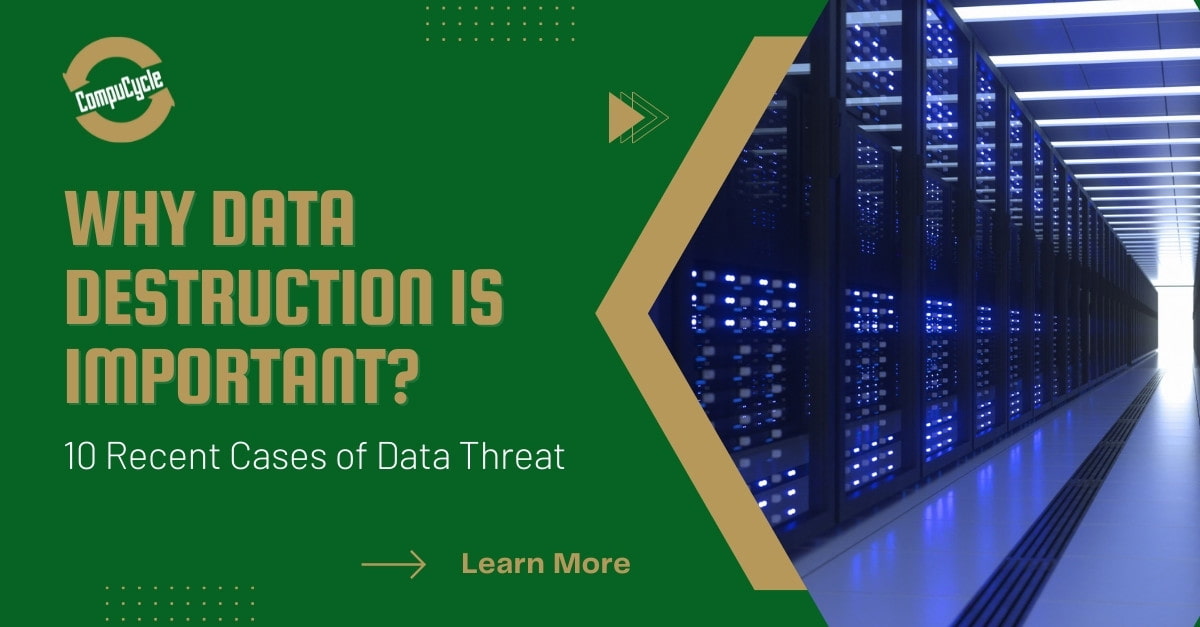The Crucial Nature of Data Destruction in Upholding Computer System Security Solutions and Protecting Against Unauthorized Access
In a period where information violations and identity burglary are increasingly common, the significance of reliable information destruction can not be overemphasized. Organizations must acknowledge that the failure to appropriately deal with sensitive details postures not only legal and economic dangers however likewise a potential erosion of customer depend on. Various methods, from information wiping to physical destruction, function as vital safeguards against unapproved access. Comprehending the ramifications of information devastation techniques and compliance with regulations elevates vital questions regarding the competence of present methods and their long-term stability in the face of advancing hazards.
Relevance of Information Damage
In an increasingly electronic world, the relevance of information damage can not be overemphasized. As companies amass vast quantities of sensitive information, the possible consequences of falling short to appropriately manage and get rid of of that information become progressively serious. Data violations, identification burglary, and business espionage present considerable threats, underscoring the requirement of reliable information devastation practices.

Additionally, as innovation develops, so too do the approaches whereby malicious stars seek to exploit sensitive info. Organizations needs to continue to be alert and positive in their information damage strategies to secure versus these developing threats. By prioritizing information devastation, business not only safeguard their properties however additionally foster trust fund among customers and stakeholders, showing a dedication to responsible data administration and protection practices.
Approaches of Effective Information Destruction
To make sure the full and permanent devastation of sensitive information, organizations can use a variety of reliable techniques customized to their particular requirements. Among one of the most typical approaches is information wiping, which involves using specialized software application to overwrite existing data numerous times, making healing practically difficult. This is particularly useful for hard disk drives and solid-state drives, where traditional removal methods are poor.
One more efficient technique is degaussing, which uses strong magnetic areas to disrupt the magnetic domains on storage media, providing the data irretrievable. This approach is particularly suited for magnetic storage space tools, such as disk drive and hard drives.
Physical destruction is likewise a viable choice, entailing the shredding, squashing, or incineration of storage space devices. This approach warranties that information can not be recuperated, making it optimal for organizations taking care of highly sensitive details.

Compliance With Information Protection Regulations
Organizations need to not only concentrate on efficient information devastation techniques yet likewise make sure conformity with data protection regulations that govern exactly how sensitive details is handled and disposed of. Adhering to these policies is vital for safeguarding personal data and keeping consumer trust. Rules such as the General Data Security Policy (GDPR) in the European Union and the Health And Wellness Insurance Coverage Transportability and Liability Act (HIPAA) in the USA impose strict standards on information monitoring, that include requirements for the safe and secure disposal of delicate information.
To accomplish conformity, companies must carry out thorough data destruction plans that line up with these legal structures. This includes recognizing data that calls for damage, developing methods for secure methodsâEUR" such as shredding physical media or using software application that meets industry standards for information wipingâEUR" and maintaining thorough records of destruction tasks. Regular audits must be carried out to guarantee adherence to these policies and to recognize any type of prospective locations for improvement.
Failing to abide by data defense guidelines can cause considerable legal implications, consisting of substantial fines and damage to an organization's credibility. Consequently, integrating compliance into information destruction techniques is not only a lawful responsibility yet additionally a vital element of a robust info security approach.
Effects of Poor Data Handling
Poor data handling can cause extreme repercussions that expand beyond prompt operational obstacles. Organizations may deal with significant financial losses because of information violations, which often cause pricey remediation initiatives, legal costs, and regulatory fines. These financial effects can prevent and stress sources development, ultimately affecting a company's lower line.
Furthermore, poor data handling can seriously harm a company's track record. Stakeholders, customers, and companions may shed count on an entity that stops working to secure sensitive details, leading to decreased customer commitment and possible loss of business opportunities. This disintegration of count on can take years to restore, if it can be brought back at all.
In addition, companies could encounter legal ramifications occurring from non-compliance with data protection laws. Such infractions may lead to penalties and examinations, compounding the financial worry and further tainting the organization's why not find out more image.
In the world of cybersecurity, inadequate information administration methods can produce vulnerabilities that make systems much more prone to unapproved gain access to and cyberattacks. Eventually, these consequences underscore the critical relevance of carrying out robust data taking care of treatments to safeguard sensitive details and preserve business integrity.
Best Practices for Secure Information Disposal
/prod01/channel_3/media/tcd/itservices/images/Untitled-design-(26).png)

To start with, information ought to be categorized according to its sensitivity. Sensitive information requires a lot more extensive disposal methods, such as shredding physical papers and using advanced software for digital data wiping. Employing licensed data damage services makes sure conformity with market regulations and standards.
Secondly, companies must apply a data disposal plan that mandates routine audits. This plan should lay out the procedures for information retention and devastation, making certain that outdated information is disposed of without delay and safely. Training employees on these methods is necessary to promoting a culture of safety and security awareness.
Finally, maintaining detailed records of disposed information enhances liability and offers a clear audit trail. This paperwork must include the sort of information damaged, the method utilized, and the date of disposal.
Verdict
Adopting robust techniques such as data cleaning, degaussing, and physical devastation, together with conformity with laws like GDPR and HIPAA, is important for protecting delicate information. Ignoring proper data disposal methods can lead to extreme repercussions, including data breaches and legal repercussions.
In a period where information violations and identity burglary are progressively visit site common, the value of reliable information destruction can not be overemphasized. data destruction. Data breaches, identity burglary, and company reconnaissance pose considerable risks, emphasizing the need of reliable data a knockout post damage practices
Conformity with policies such as GDPR and HIPAA mandates that organizations apply rigorous information defense actions, including the protected destruction of data at the end of its lifecycle.
By focusing on information devastation, business not just protect their properties however additionally foster trust amongst customers and stakeholders, showing a commitment to liable information monitoring and safety and security practices.
Organizations have to not just focus on efficient data destruction approaches however additionally ensure compliance with data defense laws that regulate how delicate info is dealt with and disposed of.